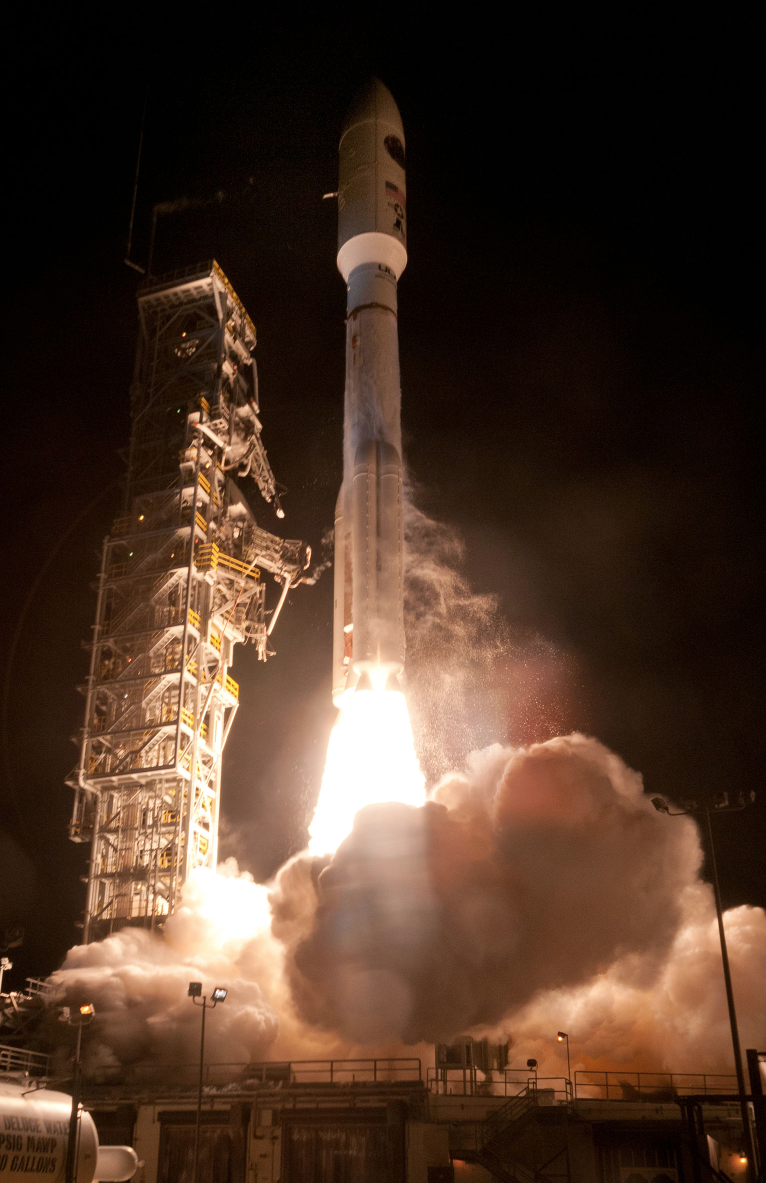Vandenberg Air Force Base, California, (December 12, 2014) – A United Launch Alliance (ULA) Atlas V rocket carrying a payload for the National Reconnaissance Office (NRO) lifted off from Space Launch Complex-3 on December 12 at 7:19 p.m. PST. Designated NROL-35, the mission is in support of national defense.

Vandenberg Air Force Base, California (December 12, 2014) – A United Launch Alliance Atlas V rocket carrying a payload for the National Reconnaissance Office lifted off from Space Launch Complex-3 on December 12 at 7:19 p.m. PST. Designated NROL-35, the mission is in support of national defense. Photo Credit: United Launch Alliance
“We are honored to deliver the NROL-35 spacecraft to orbit together with our customers, the NRO Office of Space Launch and the Air Force,” said Jim Sponnick, ULA vice president, Atlas and Delta Programs. “This mission was launched on the most powerful Atlas ever launched from California with more than 2 million pounds of liftoff thrust. This was enabled by the addition of the four solid rocket motors, providing additional performance as required to meet our customer’s needs.”
This mission was launched aboard an Atlas V Evolved Expendable Launch Vehicle (EELV) 541 configuration vehicle, which includes a 5-meter diameter payload fairing along with four Aerojet Rocketdyne solid rocket motors attached to the Atlas booster. The Atlas booster for this mission was powered by the RD AMROSS RD-180 engine and the Centaur upper stage was powered by the inaugural flight of the Aerojet Rocketdyne RL10C-1 engine.
“ULA is extremely pleased with this first flight of the new, RL10C-1 engine,” said Sponnick. “We have been working closely with Aerojet Rocketdyne and our Air Force customers for several years to develop and extensively test this next-generation engine to enable the most reliable and cost-effective upper stage propulsion for our Atlas and Delta programs.”
ULA's next launch is the Atlas V Mobile User Objective System (MUOS-3) satellite for the United States Navy scheduled for January 20, 2015 from Space Launch Complex-41 at Cape Canaveral Air Force Station, Florida.
The EELV program was established by the United States Air Force to provide assured access to space for Department of Defense and other government payloads. The commercially developed EELV program supports the full range of government mission requirements, while delivering on schedule and providing significant cost savings over the heritage launch systems.
With more than a century of combined heritage, United Launch Alliance is the nation’s most experienced and reliable launch service provider. ULA has successfully delivered more than 90 satellites to orbit that provide critical capabilities for troops in the field, aid meteorologists in tracking severe weather, enable personal device-based GPS navigation and unlock the mysteries of our solar system.
For more information on ULA, visit the ULA website at www.ulalaunch.com .
The Patches of U.S. Spy Satellites: Do They Tell Us Anything?
Enthusiasts examining the patch for NROL-35 think the trident, fire and breeze through the character’s hair might represent the elements—water, fire and wind. “What that has to do with the actual payload, however, is anyone’s guess,” says space historian Robert Pearlman. (National Reconnaissance Office)
A purple-haired sorceress holding a fireball. A three-headed dragon wrapping its claws around the world. A great raptor emerging from the flames.
No, these are not characters from a Magic: The Gathering deck. They are avatars depicted on the official mission patches made for the National Reconnaissance Office (NRO). Just as NASA creates specially designed patches for each mission into space, NRO follows that tradition for its spy satellite launches. But while NASA patches tend to feature space ships and American flags, NRO prefers wizards, Vikings, teddy bears and the all-seeing eye. With these outlandish designs, a civilian would be justified in wondering if NRO is trolling.
Unfortunately, given the agency’s extreme secrecy, it’s impossible to answer that question for sure. But based on information that has been leaked about some of the patches, it seems there may be a method to the artistic madness. You can read more about this and other patches here.
By Rachel Nuwer, Smithsonian Magazine, December 9, 2014